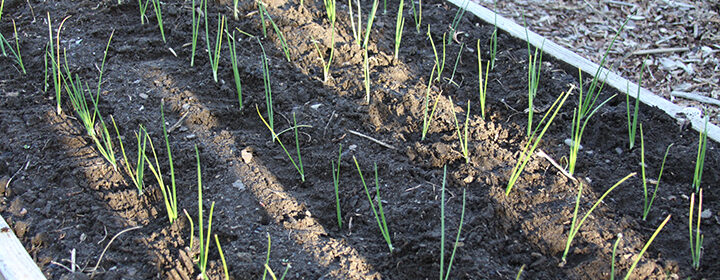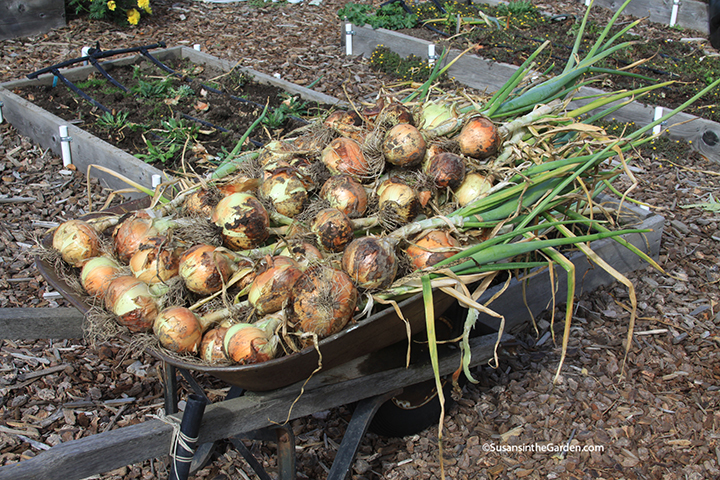How to Grow Onions

You will definitely want to grow onions because there are so many uses for them in the kitchen. Learn the important of choosing varieties appropriate for your region and the different ways you can start the plants below.
Latin Name: Allium cepa
Plant Family: Onion (Amaryllidaceae)
Cool-season crop
Did You Know?
Onions are divided into types, based upon the number of daylight hours a region receives. The bulbs start developing once the day length is appropriate for its type. For example, there are short-day, intermediate-day and long-day onions that correspond with different areas of the country. For the best possible success, take this into account by selecting a cultivar of the right type for your region. To choose the correct type, select short-day if you live in a latitude between 25 to 35, intermediate-day for latitudes of 32 to 42, and long-day for latitudes of 37 to 47.
NOTE: If you’d like to hear how my husband Bill chooses onion varieties, don’t miss this blog post: How to Grow Onions & Shallots.
Plant Seeds or Seedlings? To grow onions, start from seeds indoors or out, from sets (small bulbs), or from plant starts. Why would you grow onions from seeds? It’s difficult to find some interesting varieties as starts or sets.
When: If starting indoors, plant seeds about 12 weeks before sowing them out in the garden. If direct-sowing in your garden — or transplanting seedlings, sets or starts — do this in early spring as soon as the soil can be worked.
Days to Germination: Seeds take 10 to 14 days.
Depth to Sow: 1/4 inch (seeds). Plant sets so there is 1 inch of soil above the top of the onion bulb. If planting starts, bury the bottom inch in the soil.
Spacing: Sow seeds 1 to 2 inches apart, sets 2 inches apart, or plant starts 4 inches apart. Both seedlings and onions growing from sets will eventually need to be spaced 4 inches apart. There’s a tasty way to accomplish this. Harvest every other onion to provide the remaining onions with enough room to grow and mature. Be sure to use those thinned onions in your kitchen!
Cultural Information:
Prepare the soil by working bonemeal into the top 3 inches. Plant seeds, seedlings, sets or plant starts at the recommended spacing above. Pull weeds as needed so they won’t compete with the developing onions for nutrients or moisture. Be sure to water the bed on a regular basis. Remember to thin the onions to optimal spacing, as mentioned above.
Susan’s Picks:
Short day: ‘Gabriela’, ‘Texas Early White’, ‘Texas Super Sweet’, ‘White Castle’
Intermediate day: ‘Red Candy Apple’, ‘Scout’, ‘Sierra Blanca’
Long day: ‘Ailsa Craig’, ‘Highlander’, ‘Italian Red Torpedo’, ‘Patterson’, ‘Red Wing’, ‘Ringmaster’, ‘Walla Walla Sweet’, ‘Yellow Sweet Spanish’
Potential Insect Problems: onion maggots
When to Harvest:
When you grow onions, they can be harvested any time during the season. As scallions (green onions), as small onions, or when the bulbs are full-size. If you are growing them to store for later use, wait until the stalks fall over, which means the plants have finished growing. Turn off the water to the bed and pull up the onions. Then move them to a sheltered area such as under a carport or in a shed until the skin is papery dry.
How to Cook & Preserve:
Onions have so many culinary uses. Saute them for omelets or with other vegetables. Add them to soups, stews, casseroles and side dishes. Roast them in the oven with other root crops. To store mature onions that have gone through the drying process (refer to “When to Harvest” above), place them in a cool, dark location. We use our garage or basement for this. When it comes to the amount of time onions will keep in storage, it varies widely between cultivars. Be aware of this and use the ones that don’t keep for a long time first. It’s also possible to chop up onions, place them in freezer bags and freeze them to use later.
My Videos About Onions:
- How to Grow Onions & Shallots Like a Champ!
- Onions, Shallots & Garlic: You Grew It, What to Do With It!
- Grow Onions
Back to Vegetable Grow Guide Chart
Copyright: Susan Mulvihill, Susan’s in the Garden, SusansintheGarden.com.

